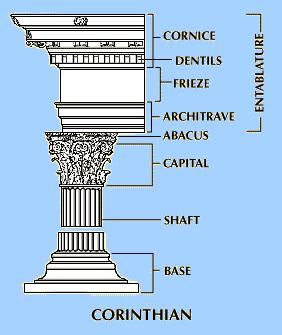Corinthian Order
It is said that the Corinthian order was invented by an architect Callimachus. He was inspired by the sight of a votive basket that had been left on the grave of a young girl. There were a few of her toys in it. Over the basket was a square tile to protect them from the weather. An acanthus plant grew through the woven basket, mixing its spiny, deeply cut leaves with the weave of the basket. A Corinthian column is almost always fluted. In its proportions, it is similar to the Ionic column, though it may be made more slender, but it stands apart by its distinctive carved capital.
A Corinthian capital may be seen as an enriched development of the Ionic one. If you look closely at a Corinthian capital, you may see the Ionic volutes at the corners, perhaps reduced in size and importance, scrolling out above the two ranks of leaves, and the smaller volutes scrolling inwards to meet each other on each side. The architrave is divided into two or three sections, which may be equal, or they may bear interesting proportional relationships, one with another. One of the oldest examples of the Corinthian order is the Choragic There are several copies of the Choragic Monument of Lysicrates found in gardens throughout England including Shugborough, Staffordshire and Alton Towers. In Connecticut, USA, they have dedicated theirs to a Civil War Memorial.
|

 Corinthian order is the most ornate of the classic orders of architecture. It was also the latest one, having developed in the middle of the 4th century BC. However, the Greeks seldom used the style.
Corinthian order is the most ornate of the classic orders of architecture. It was also the latest one, having developed in the middle of the 4th century BC. However, the Greeks seldom used the style. Acanthus mollis
Acanthus mollis Monument of Lysicrates (c.335 B.C.), a graceful circular structure showing one of the early uses of Corinthian columns. It was constructed in ancient Greece to commemorate the victory of the leader of a chorus in the competitive choral dances.
Monument of Lysicrates (c.335 B.C.), a graceful circular structure showing one of the early uses of Corinthian columns. It was constructed in ancient Greece to commemorate the victory of the leader of a chorus in the competitive choral dances.


